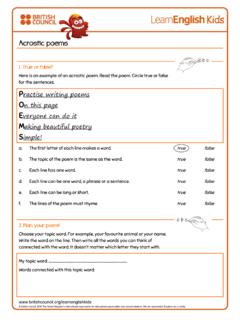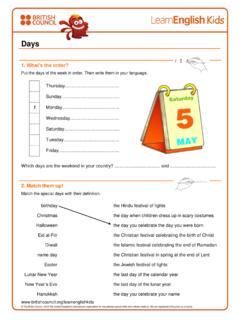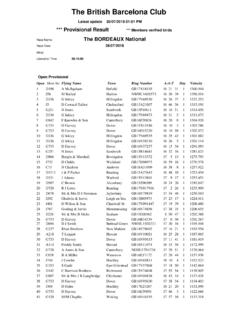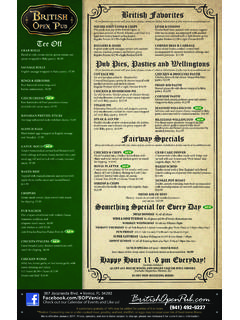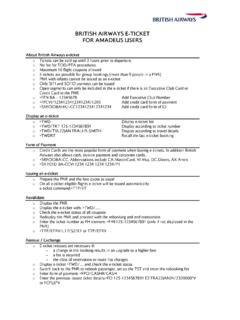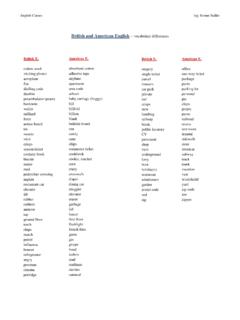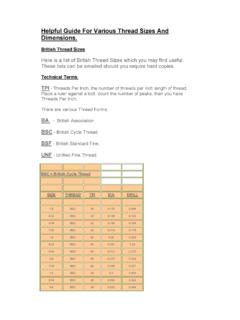Transcription of British Seagull txt - LAGERHOLM.COM
1 British Seagull "The best Outboard motor for the World . Arne Lagerholm, Sweden. Updated 2008-04-08. If you have seen a British Seagull outboard engine on a boat you may think it looks very antique and old. This is often not true because British Seagull is from the beginning made after a specific philosophy and for safe service under difficult conditions at sea. Many letters from happy owners were written to the factory in England. This classical letter is from a sales folder in 1985. "..it was left under a bush at the bottom of the garden for 23 years wrapped in a plastic type bag and forgotten even changing the spark plug it went on approximately the 12^th pull". Living with this and other positive testimonials from their owners British Seagull has become almost an institution among sailors all over the world. Since the first Seagull was manufactured in 1931 few basic things have been changed. The engine was at first made by the Sundbeam Motor Company and John Marston Ltd.
2 , who built the famous Sundbeam motorcycles in Wolverhampton. The first engines were named "Marston Seagull " and its cone shaped silencer looked much like a motorcycle one. The engine was developed over the years and made for different duties with different propeller sizes and gearing. Many engine parts can be changed between the models. The same spare part can also be used for different models. The design of the engine is simple and rugged and it demands a minimum of service and can be dismantled by simple tools. It is made of pure marine grade materials and for service in salt water and will last for many years. It is not uncommon to find a Seagull after 40. years of use to be as new after cleaning up. All Seagull engines are made for use at boats with displacement hull. Boats that goes through the water and not more or less above it. The engines have no bearings but large bronze bushes which means that an engine can by accident go overboard and still be saved.
3 The propeller is large and made for modest rpm. During WW II the British Admiralty ordered a "rough and tough" version of "Model 102" for use at light boats. At least engines were made in a short time. Some of these engines only made one single journey to destruction but a lot were saved and used until our days. After some years Marston Seagull production rights was bought out by the two engineers and entrepreneurs John Way-Hope and Bill Pinninger. The two men had earlier worked at the engineering department at Sundbeam Motor Company developing the Seagull engines. The production was moved to Poole and the new company renamed the engines to: British Seagull "The Best Outboard Motor for the World". John Way-Hope has written the very enjoyable, readable and useful, today classical manuals about how to use and maintain your British Seagull . In his very special way generations of owners with minor technical know-how learned how to best use their engines.
4 Quotes from: "Operating instructions for the Models 40 & 100 Seagulls". - Your " Seagull " does not ask for very much, and there is no difficulty in giving it what it do not write this book for fun, we do it because it is vital for your own pleasure, security and peace of mind. - Do not do your first trip with a new engine under rush conditions, in front of a large audience. For instance, avoid a vital trip, catching the last of the tide, in a small dinghy, laden to the gunwales with gear and people, in half a gale in the pouring sounds silly, but it is exactly what people do only too frequently. - Choose fine weather useful, and, if possible, seamanlike and mechanical quiet and secluded spot, where success or otherwise does not matter your time, and see that the engine is fitted exactly as laid down in these instructions, and get set thoroughly with the new mechanism before starting serious business. - It is absolutely essential that the fundamentals in life is provided for a motor, and almost all the ailments attached to outboard motoring can be accounted for by the attitude of "It does not old plug will old oil that is in any need to read the instructions, I know all about mind about fixing the engine on the boat properly, we are in a will will do," etc.
5 , etc., ad nauseam . Let us say at once, this will not is asking for trouble. 1. The Seagull is a pure-bred marine engine, for a hard life on salt water. 2. It is designed for a rich oil mixture to provide not only unlimited life, but adequate oil protection from the internal corrosion always associated with the long periods of idleness inseparable from service at sea. Lubrication of the gearbox. You must not use grease. Oil only must be used. Any good quality gear oil will do, of approximately 140. viscosity. From 1978/1979 models, EP 90 was recommended. Fill up to filler plug hole measured with engine in upright position. The sparking plug. Nearly 90% of engine failure is due to plug trouble, and yet, plug trouble is almost entirely avoidable. Use the right plug "Champion D16" or equivalent. Points gap in. (0,5 mm). For later models with breakerless ignition in (0,9 mm), not less. Always carry a spare, good, just another plug which has probably been rejected faulty on some previous occasion!
6 If the engine cuts out suddenly or do not start after tree or four pulls it is ten chances to one that it is plug trouble. Whip out the plug at once and check. The boat and speed. Now as regards obtaining maximum speed from the whole outfit: First of all, in any displacement dinghy, that is to say one which goes through the water, as opposed to a speed dinghy which planes on top of it, maximum possible speed of the boat is governed entirely by the length of the boat and not by the power exerted by the engine. To some this may be surprising but it is a fact. As a rough guide, a 9-foot hull will reach knots and a 16-footer 6 knots; other lengths in proportion. Always remember, however, that it is a waste of effort to try and drive a boat above its calculated maximum referred to above. Do not use a scrap more throttle opening than is necessary. The most economical cruising speed is with the throttle lever a third open approximately in line with the tiller.
7 Technical data and useful information about British Seagull engines. The following is from a folder was published by the former distributor in Sweden, AB Motor Reimers in Stockholm and dated from 1. January 1957. Model 40 (Code SJM). This engine is for 6-9 foot dinghies with low transom and in the category hp. An easy motor to handle and liked by ladies and children. Space: 851x267x318 mm. Model Super 40 Plus (Code SJP). This engine gives about hp and is the ideal engine for 8-12 foot dinghies, 4-5 m rowing boats and as stand by power for smaller sail boats. Space: 953x267x318 mm. Model Super 40 Plus, Long (Code SJP-L). For boats as above with higher transom this engine is 150 mm longer but gives the same gear reduction and has a large 4-bladed propeller. Space: 1105x267x318 mm. Model 100 Century (Code LLS). This is the latest engine in the Seagull family. It is developed with a detachable cylinder head (square cylinder head), lower fuel consumption and larger gear reduction.
8 Space: 953x267x318 mm. Model 100 Century, Long (Code LLS-L). Same as above but 150 mm longer. Ideal stand by power engine for larger sail boats. Space: 1105x267x318 mm. Model 102 (Code TC). This engine gives about hp at ca. rpm. With the right boat it will make up to 7 knots. Space: 1054x330x305 mm. Model 102, Long (Code TC-L). For boats with higher transom you can use this engine which is 150 mm longer than TC. Space: 1210x330x305 mm. Modell 102 Plus (Code THC). This engine gives more power than the above, large gear reduction and has 4-bladed propeller with high thrust and can tow sailboats of 8-20 tons displacement in calm weather. Space: 1150x330x305 mm. Model 102 Plus, Long (Code THC-L). Same engine as above but for boats with higher transom. Space: 1300x330x305mm. Note! British Seagull never claimed effect in hp for their engines but talked about the propeller thrust it gives as this is a better measure for displacement boats. The hp categories given above are based on theoretical calculations.
9 By different diameters of the propeller and different gearing the engines were optimised for their respective use. Letter "C" in code are clutch models. Letter "L" in code means long shaft model. British Seagull . Some technical data and important notes. Code Bore mm Stroke/cc RPM max Gear/Propeller Length*)mm SJM 45 40/64 2,1:1/160mm 355. SJP 45 40/64 3,5:1/230mm 410. SJP-L 45 40/64 3,5:1/230mm 560. LLS 57 40/102 3,5:1/230mm 410. LLS-L 57 40/102 3,5:1/230mm 560. CP 57 40/102 4,0:1/300mm 410. CP-L 57 40/102 4,0:1/300mm 560. CPC 57 40/102 4,0:1/300mm 410. CPC-L 57 40/102 4,0:1/300mm 560. TC 57 40/102 3,0:1/230mm 425. TC-L 57 40/102 3,0:1/230mm 575. THC 57 40/102 4,0:1/330mm 425. THC-L 57 40/102 4,0:1/330mm 575mm Distance*) between bracket and water line: *SJM=355 mm, SJP=410-425 mm, SJPL=555-565 mm, LLS=410-425 mm, LLSL=555-565 mm, TC & THC=410-425 mm, TCL & THCL=555-575 mm. Recommended gearbox oil: EP 90, gear oil for models: FS, EFS, FPC, EFPC, SC, ESC, EFNR, ENC, EN.
10 SAE 140, gearbox oil is unsuitable for: FS, EFS, 55, 75, 90, 125 and 170 models. Change gearbox oil at least every season. Check correct level often. It is normal for a small amount of water to enter the gearbox. This will not harm the gears or bearings. Useful spares and tools: Extra spark plug, propeller safety spring and split pin, starting cord, combination spanner and screwdriver. Model identification. The model identification is the first group of letters of the serial number on the crankcase. This group may have the letter "L" on the end which denotes a long shaft engine. Petrol/oil 25:1 4% petrol/oil ratio. All engines manufactured from January 1978 are designed to operate on a 25:1 petrol/oil ratio. Use low octane fresh commercial grade petrol and mineral outboard motor oil. The oil ratio /must not/ be cut below this. Older engines can be converted to this ratio if some modifications are made. Older engines must have 10:1. petrol/oil ratio.
